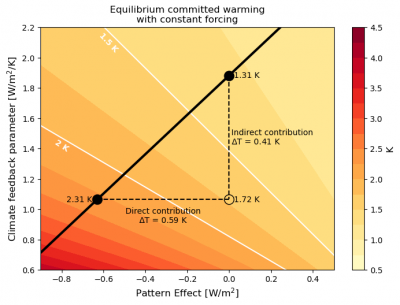Greater Committed Warming After Accounting for the Pattern Effect
Scientists at Lawrence Livermore National Laboratory in collaboration with colleagues from Nanjing University and Texas A&M University have re-evaluated how much future global warming is in the pipeline if atmospheric greenhouse gas concentrations were to remain fixed at present-day levels, a quantity known as committed warming. Their new analysis accounts for the fact that surface warming to date has been large in certain regions but small in others, which has temporarily allowed Earth to shed heat more efficiently. Ignoring this “pattern effect”, as has been done in previous studies, gives the false impression that Earth’s energy budget is nearly balanced and implies that committed warming is only about 1.3°C (2.3°F) above pre-industrial levels. The team’s updated estimate is substantially larger, with a most likely value of 2.3°C (4.1°F).
The study demonstrates that properly accounting for patterns of warming is crucial for balancing Earth’s budget and for accurately quantifying how much additional warming is in the pipeline if greenhouse gas concentrations are frozen at present-day levels. Ignoring these effects leads to a substantial underestimate of committed warming, and hence an overly optimistic view of the remaining headroom to avoid exceeding target temperature thresholds such as those set in the Paris Agreement. The correction due to the pattern effect remains uncertain, however, highlighting the need for stronger observational constraints on its magnitude.
Earth’s energy balance is sensitive to spatial inhomogeneities in sea surface temperature and sea ice changes, but this is typically ignored in climate projections. In this work, it is shown that the energy budget during recent decades can be closed by combining changes in effective radiative forcing, linear radiative damping, and this pattern effect. The pattern effect is of comparable magnitude but opposite sign to Earth’s net energy imbalance in the 2000s, indicating its importance when predicting the future climate on the basis of observations. After the pattern effect is accounted for, the best-estimate value of committed global warming at present-day forcing rises from 1.31 K (0.99–2.33 K, 5th–95th percentile) to over 2 K, and committed warming in 2100 with constant long-lived forcing increases from 1.32 K (0.94–2.03 K) to over 1.5 K, although the magnitude is sensitive to sea surface temperature dataset. Further constraints on the pattern effect are needed to reduce climate projection uncertainty.

